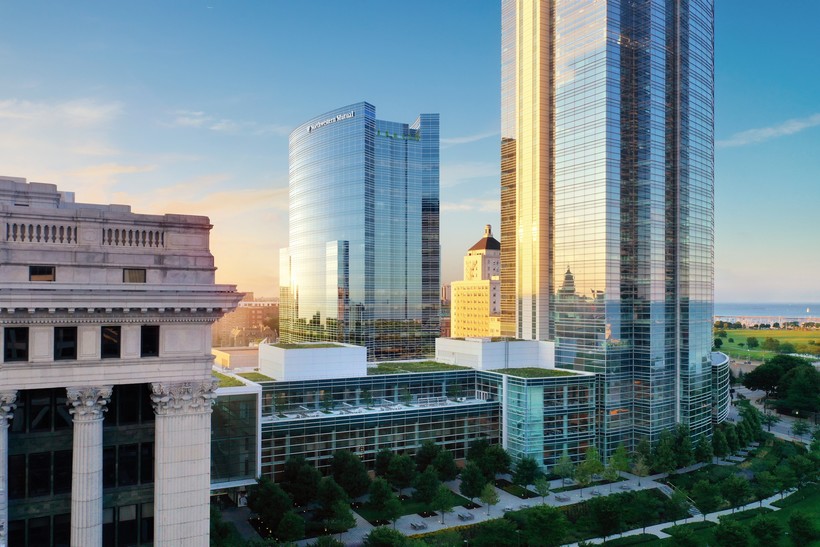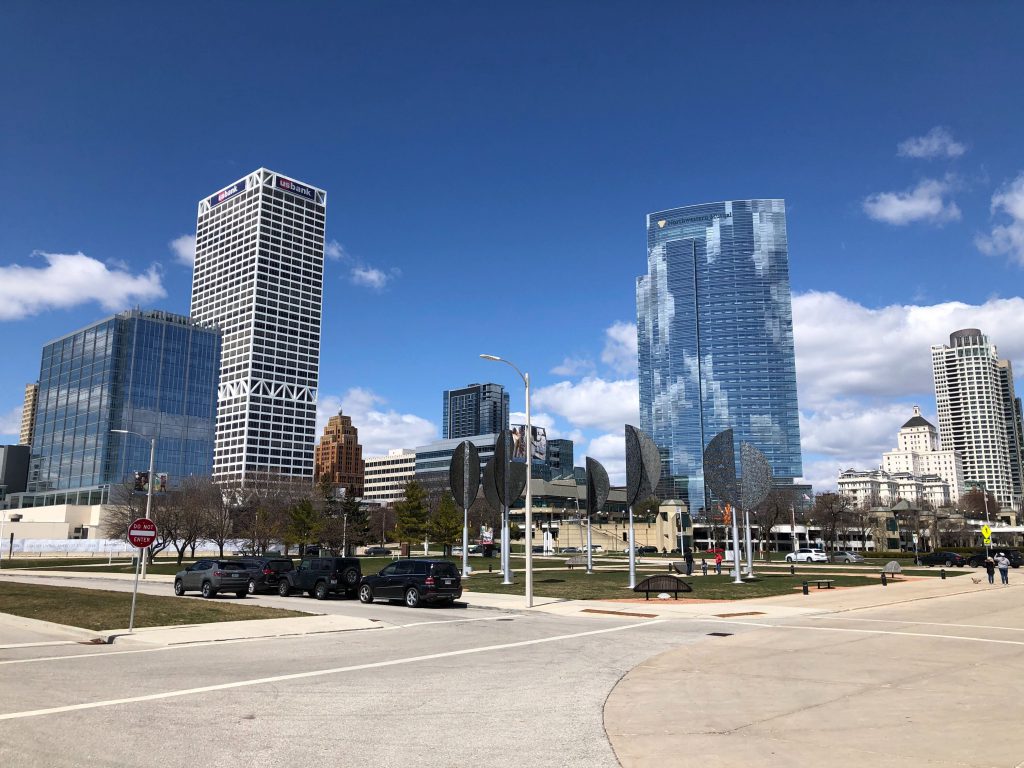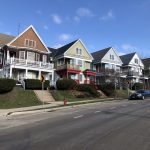Mayor Johnson’s Plan to Nearly Double Milwaukee’s Population
Hopes to grow city's population from 577,222 to 1 million. How will he do it?
As a kid, Milwaukee Mayor Cavalier Johnson was infatuated with the forest green population signs along the side of the road at Milwaukee’s borders.
He’d often study the numbers on the signs while riding on the school bus. But over the years, he noticed as the population number on that sign ticked down.
Now, as mayor, one of Johnson’s main goals is to increase the city’s population to 1 million residents. It’s a lofty goal, but it’s one he said he believes is achievable.
The city likely could have reached 1 million residents if population trends in the early 20th century continued. Instead, the city’s population is now about 22 percent lower than it was at its peak in 1960.
“I, as mayor, want to see this growth,” Johnson said. “I want more people to be a part of this community. I want there to be more family supporting jobs. I want more people to celebrate this city that all of us love.”
“My thought is we should be ambitious about this, we shouldn’t simply nibble around the edges and try to remain a city of 600,000 people or so — we should be trying to grow the city,” Johnson added.
In order to achieve the goal, Johnson said he’s trying to put in place policies to attract economic growth and stability in neighborhoods. On the top of that list is updating the city’s zoning code to allow for more density.
“Looking to that 1 million number really would put us in a position where we would be more than just a city that’s a whisper,” he said. “We would be a part of the conversation with some of the other major metropolises across the country that are growing. I want Milwaukee to be in the mix.”
Even with the goal, there were more deaths than births for the second straight year in Wisconsin last year, according to U.S. Census Bureau numbers.

Milwaukee Mayor Cavalier Johnson poses for a photo in his office in city hall on Wednesday, Feb. 15, 2023. Evan Casey/WPR
Years of population decline
At its peak, the city had a population of 741,324 in 1960. At that time, it was the 11th largest city in the nation.
Today, Milwaukee is the 30th largest city in the nation.
“The migration of city dwellers to the suburbs that began with the automobile was accelerated by massive freeway development in the 1950s and the development of newer, larger housing options in outlying areas,” a city population report said. “Smaller family size, loss of manufacturing jobs, and other factors exacerbated the loss of population in the city.”
But even as the population in the city has declined, the total gross domestic product from the greater Milwaukee area has continued to rise.
Milwaukee was one of the few Midwestern “Rust Belt” cities that actually grew in population from 2000 to 2010. But the loss of about 17,000 residents in the last decade could also be reversed, as city officials have challenged the 2020 census. The city’s department of administration estimated the 2020 census undercounted the population by around 16,500 people.
John D. Johnson is a research fellow at the Lubar Center for Public Policy Research and Civic Education at Marquette University Law School. He said lower birth rates in Milwaukee has led to the decline. Johnson also said the north side of the city, which has high numbers of Black residents, is seeing declines in population — likely due to high rates of poverty and low employment options.
“It’s clear that for many of Milwaukee’s Black residents who are able to leave, that they do so,” John Johnson said. “The city has to solve that and that’s really a regional issue.”
How to get to 1M
Mayor Johnson said he believes the city can achieve the 1 million goal by changing the zoning code to allow for more density, adding economic opportunities and increasing public transit options.
Johnson said the East-West Bus Rapid Transit is expected to begin service later this year. That bus line will connect major employment centers throughout the city and county.
Johnson also wants to bring more family supporting job opportunities to the city. Milwaukee has recently seen an uptick in companies creating new offices in the downtown area, or increasing their footprint there. That’s bringing more workers back to the city’s central hub and driving economic growth for the city.
Northwestern Mutual announced a recent plan to move nearly 2,000 employees back to downtown Milwaukee in the next three to five years, redesigning an older building in the process. Other companies, including Kohl’s, SoftwareONE, Miller Electric Mfg, the American Heart Association, CBRE Group, Inc. and Potawatomi Business Development Corp. have also announced similar plans.

Northwestern Mutual announced plans to invest more than $500 million in its North Office Building in downtown Milwaukee. Photo courtesy of Northwestern Mutual
Johnson said he’s been “laser focused” on raising the city’s population ever since he was an alder for the Milwaukee Common Council. He would also like to create more affordable housing options, which has been a goal for the city, and state, in recent years.
“To the extent that a city can encourage immigration, refugee resettlement, these kinds of things, that’s a good way to grow your population,” John Johnson said. “But the city doesn’t have a lot of control over immigration policy, which is set by the federal government.”
Mayor Johnson said the city is becoming a safer place to live in, as millions of dollars have been spent to address reckless driving. And while Milwaukee broke its homicide record for the third year in a row last year, Johnson said violent crime in the city is down.
“We’re headed in the right direction,” Johnson said.
Listen to the WPR report here.
Milwaukee’s mayor wants to reverse decades of population decline to get city to 1M residents was originally published by Wisconsin Public Radio.
More about the Growing MKE proposal
- Milwaukee Seeks ‘Missing Middle’ Housing Developers - Jeramey Jannene - Nov 24th, 2025
- Milwaukee Aims To Build ‘Missing Middle’ Housing in 2026 - Jeramey Jannene - Oct 29th, 2025
- Despite Its Passage, ‘Growing MKE’ Still Not A Done Deal - Jeramey Jannene - Sep 16th, 2025
- Mayor Signs Housing Legislation, Praises Late Jonathan Brostoff - Jeramey Jannene - Jul 16th, 2025
- Council Adopts Growing MKE Plan - Jeramey Jannene - Jul 15th, 2025
- After Lengthy Debate, Council Legalizes Carriage Homes - Jeramey Jannene - Jul 15th, 2025
- Housing Plan Wins Key Council Committee Endorsement - Jeramey Jannene - Jul 9th, 2025
- City Hall: Committee Waters Down Proposed ‘Granny Flat’ Plan - Jeramey Jannene - Jun 17th, 2025
- Madison Pursuing Its Own Zoning Reform Similar To ‘Growing MKE’ - Sarah Lehr - Jun 12th, 2025
- ‘Growing MKE’ Proposal Picks Up Key Endorsement - Jeramey Jannene - Jun 2nd, 2025
Read more about Growing MKE proposal here























Build and renovate 200k houses in MKE and perhaps it can be done.
I’m an absolute promoter of Daniel Burnham’s maxim, “Make no small plans,” and this definitely falls into that category. Bravo!
It sounds like the mayor has a solid grasp of the various levers the City need to flip to make this happen. At first blush, I think “economic opportunity” is a huge one. Milwaukee simply doesn’t have the (high) tech workforce needed to attract companies wishing to expand somewhere, so it will need to focus on companies willing to relocate employees and on quality of life factors/amenities attractive to key employee profiles the City is lacking in. It’s a bit of chicken-and-egg but it can be done.
A couple of other things:
(1) Immigrants – Yes! Great this is on he radar screen. Immigrants from countries with low economic and personal opportunity tend to work hard here in pursuit of “The American Dream” and a significant number are entrepreneurial, creating businesses that grow and then employ even more people. I was reading in the Business Journal about how clearing the immigrant backlog is a key priority for the National Association of Manufacturers as presented presented recently at Husco. Immigration reform must happen and Milwaukee and the astute must do whatever they can to increase immigration.
(2) Climate (and cost of living) Migration – The Biz Times just posted an article on this. Whiles some might not believe this, it is already happening and will increase in the next 20 years. MKE must prepare its welcome mat doe people from the coasts (especially the West Coast). When I moved back to the Midwest (Chicago) eight years ago after spending 16 years in San Francisco, I was already seeing the writing on the wall. And, among the 10-12 reasons I had for moving back were climate (the fires had already started in CA and summers were getting unusually hot) and also the desire to live in a county within the Great Lakes Basin and covered by the Great Lakes Basin Compact. In the end, I will probably be dead when the going gets really rough (more so than now!), but living with ready—and protected—access to the world’s largest body’s of fresh water seemed prudent.
Anyway, blah, blah—there goes Polaris, again! But there you have it…
We need much better transit than a couple BRT lines if we want that many people in Milwaukee. Many more bus only lanes would be needed with more frequent services.
Yes to more immigrants from other countries. This is what helped make Milwaukee prosper in the late 19th and early 20th century. Today, the US only allows about a million immigrants per year. We could easily do five. It would also help solve our Social Security issue – though that also could be easily solved by taxing all income.
Polaris…well done. Especially point #2. Milwaukee will be looked at closely as a safe haven for what are essentially coastal refugees. Will we be ready? Or will Detroit, Minneapolis, Des Moines and Madison get out ahead of our notorious caution?
Watch for this new wrench in the works – the US is running up against a capacity limit on new energy sources due to the carrying capacity of existing lines.
I’m sure there are places where this is just another tobacco/oil style ploy, but by and large it seems real.
If it’s true here, to what degree? Transit mode planning and consumer mobility purchases will be strong factors and may be the two that we have the most control over. Transit will need a good share of our energy and drivers, bikers and walkers will demand a reasonable [Hopefully] share.
Individual solar, wind and other modes can be wired into individual homes/properties. However, there needs to be a way to remotely cut these off from from the grid in areas where workers are trying to restore interrupted grid power. For safety, they need to work with that grid
totally off – not live with consumer-provided power.
More user-generated power could free up some capacity on the grid which could go to other important uses – hospitals, police, fire and rescue etc.
If we double our population, expect to find that transit plans we’ve made or discussed may fall short.
The fastest, most cost/space-efficient, weather-defiant mode is rail rapid transit. Providing right-of-way is a serious commitment and expense. There may be an interim approach, one used to serve a massive slum without kicking everyone out.
They used an overhead cable tram.
If this is seen to be only an interim step, the route of this system and the placement of its support structures should be done as follows:
Tram support structures should be located on plots large enough to accommodate structures for tram and the rapid rail mode. These plots should be large enough and the tram supports tall enough to allow rail construction without interrupting tram service. Between these locations additional rail support plots should be designated, and reserved for future use.
Location plans must consider both engineering and social needs plus train/bus transfer integration.
We’ll need immigrants from inland as well as coastal areas.
In past comments I’ve mentioned we need
immigrants who know how to plant, cultivate, optimize, monitor, protect and harvest new crops for our new climate. That will be largely rural.
Milwaukee, and other urban areas, must include others who know the science and steps from crop to table, including transportation, processing, preserving and storage needs/facilities, shelf life, nutrition, recipes, etc. You can’t eat what you don’t know how to preserve or prepare.
We also need to welcome people who can make needed things here that they can no longer make for us at home. This applies to domestic use or export.
We also have a moral obligation to mitigate the problems we’ve caused or intensified from our comfortable and oblivious northern lifestyle/climate.
I admire Mayor Johnson’s vision for a million-person Milwaukee, and as a Milwaukee resident, I am 100% in favor of it. This goal motivates action on many issues for the city: increasing revenue through more productive use of urban land, increasing density to make transit such as The Hop streetcar successful, increasing the attractions and activities in the city to make it more prosperous, and providing a framework for the pride and destiny of a city that has a great gift of geography, commerce, and culture. This is a clear goal that inspires–the best kind of big-picture vision for leadership. There is no doubt that Milwaukee faces many complicated, ongoing, serious, and persistent problems. This goal does not hide those problems but provides inspiration and motivation to address them. All great cities are complicated, but Milwaukee has been stagnant too long, and it is in the right place at the right time to seek a vision of smart growth to address many issues. Many people don’t or won’t see this, as they use the circular thinking of “Milwaukee has problem X, and since it has problem X, nothing can be solved until X is solved. ” Solutions to complicated problems involve multiple approaches on all fronts and an understanding of how cities worldwide have changed through history. A million-population goal itself may not even be the most important outcome of this vision 10 or 20 years from now, but this goal now fits as a great motivator for the city.
Here’s an interesting article in today’s Times about Oklahoma’s aspirations.
https://www.nytimes.com/2023/03/02/us/oklahoma-texas-rivalry.html?smid=nytcore-ios-share&referringSource=articleShare
Interesting that both Oklahoma City and Austin, TX have grown by double digits in the past decade (18% and 20%, respectively). I haven’t been to Tulsa but have been to OC. They really have been trying to deal with the historic truth that there was not a lot to do there—it’s primary challenge,
OC instituted a 1% sales tax to help pay for new things,
“Oklahoma City has taken a different tack, raising money from residents and visitors — in the form of a dedicated 1 percent sales tax — and spending hundreds of millions of dollars in recent decades on things like new parks, a canal, a streetcar system and a basketball arena. The city remade its downtown, and new shops and restaurants replaced those that had long ago vanished.”
More than 100 companies have moved some operations to OK in the past five years. The state is becoming more purple as blue-staters move there. Some, apparently, see OC as a version of what Austin used to be.